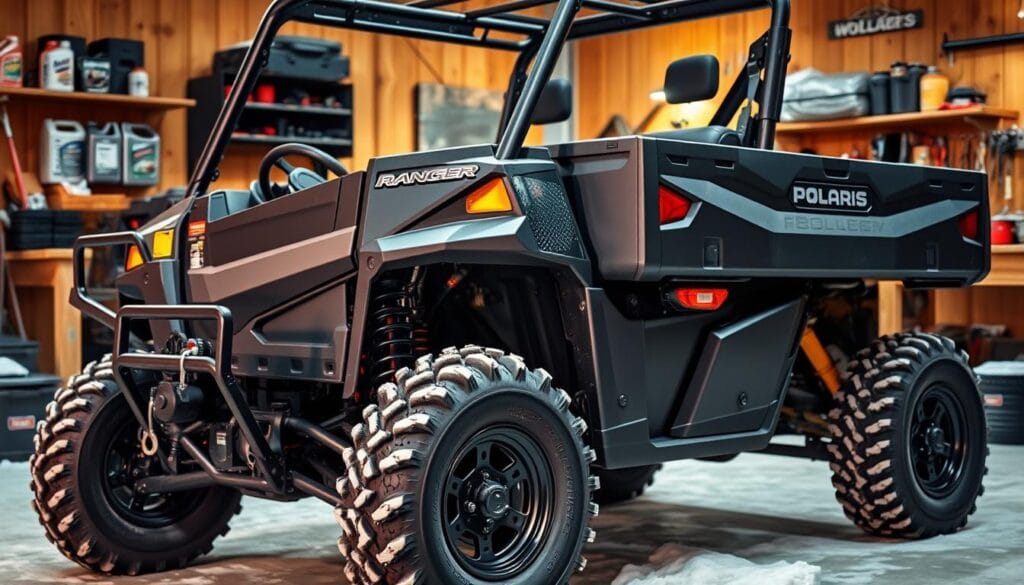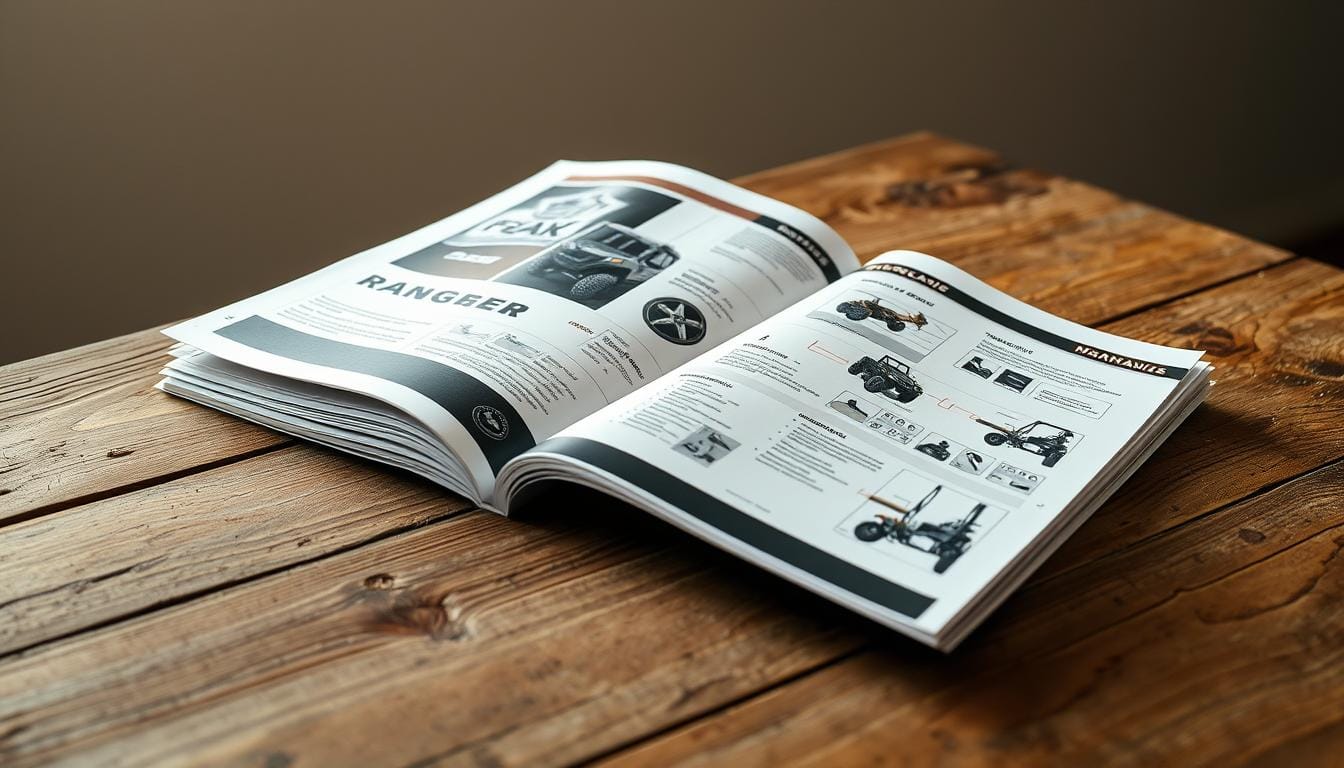Polaris Ranger Maintenance Tips
When you own a Polaris Ranger, you take on the duty of keeping it in top shape. These rugged off-road vehicles need regular care to perform at their best. Your Ranger is a big investment, and taking care of it starts with knowing the key maintenance tips.
Looking after your off-road vehicle is more than just avoiding repairs. It’s about making sure your Ranger is ready when you need it. Whether for work or fun, keeping up with maintenance can save you a lot of money and make your vehicle last longer.
Key Takeaways
- Regular maintenance prevents costly unexpected repairs
- Consistent care extends your Polaris Ranger’s operational life
- Proactive maintenance ensures peak performance in challenging conditions
- Understanding your vehicle’s specific needs is crucial
- Scheduled inspections can catch potential issues early
Understanding Your Polaris Ranger’s Maintenance Schedule
Keeping your Polaris Ranger in top shape is key. A good maintenance plan prevents expensive fixes and breakdowns. It keeps your vehicle running smoothly for years.
How and where you ride affects your Polaris Ranger’s needs. Knowing these needs helps keep your vehicle in excellent condition.
Regular Service Intervals
Polaris suggests maintenance schedules based on your riding habits. Important services include:
- Initial break-in service at 25 hours or 30 days
- Regular inspections every 100 miles or 100 hours
- Comprehensive annual check-ups
Mileage vs. Hour-Based Maintenance
Both mileage and hours matter for your ATV’s care. Intense terrain and challenging conditions can accelerate wear. So, hour-based maintenance is just as crucial.
- Mileage-based intervals work best for consistent terrain
- Hour-based maintenance suits varied riding conditions
- Combine both methods for comprehensive care
Seasonal Maintenance Requirements
Seasons change, and so do your Polaris Ranger’s needs. Preparing for extreme temperatures and conditions is vital for its performance.
- Winter: Protect against cold-weather challenges
- Summer: Check cooling systems and fluid levels
- Rainy seasons: Inspect seals and electrical components
Pre-Ride Inspection Checklist
Your Polaris Ranger needs careful attention before you hit the trails. A detailed pre-ride inspection can stop unexpected breakdowns and keep you safe. As any good UTV repair guide says, a quick check of key parts can avoid trail troubles.
Every Ranger owner manual stresses the need for a systematic pre-ride checklist. Here’s a key list of things to check:
- Tire InspectionCheck tire pressure
- Examine tread depth
- Look for cuts or damage
- Fluid LevelsEngine oil
- Coolant
- Brake fluid
- Transmission fluid
- Electrical SystemsHeadlights
- Brake lights
- Turn signals
- Battery connections
“Preparation prevents poor performance” – A golden rule for UTV maintenance
Don’t forget to check your brakes, suspension, and drive belt. These parts can wear out fast. A quick look and touch can spot problems early.
By using this pre-ride checklist from your Ranger owner manuals, you’ll lower the chance of trail surprises. You’ll also make your Polaris Ranger last longer.
Polaris Ranger Maintenance Tips for Optimal Performance
To keep your Polaris Ranger in top shape, focus on powersports maintenance and DIY Ranger repairs. Regular checks on key parts help your vehicle run well. This prevents expensive repairs and extends its life.
Proactive maintenance is key for reliable off-road performance. Knowing and using important care tips helps your Ranger perform well in different terrains.
Engine Oil and Filter Changes
Regular oil changes are vital for your Ranger’s engine health. Here’s what to do:
- Check oil levels before every ride
- Use the oil grade recommended by the manufacturer
- Replace the oil filter as suggested
- Drain old oil completely before adding new oil
“Clean oil is the lifeblood of your Polaris Ranger’s engine” – Polaris Maintenance Expert
Air Filter Maintenance
Your Ranger’s air filter keeps the engine clean from dirt and debris. Proper air filter care is critical for optimal performance. Here’s a quick guide:
- Inspect the air filter before each ride
- Clean or replace it when it’s dirty
- Use genuine Polaris replacement filters
- Check the filter housing for damage
Belt Drive System Care
The belt drive system needs regular checks to avoid sudden failures. Follow these DIY Ranger repairs for the best performance:
- Check belt tension regularly
- Look for signs of wear or fraying
- Replace the belt as recommended by the manufacturer
- Keep the belt clean and free from debris
By following these maintenance tips, you’ll keep your Polaris Ranger reliable and performing well. This saves money on repairs in the long run.
Fluid Level Monitoring and Replacement
Keeping your Polaris Ranger’s fluids in check is key for its performance. If you ignore fluid levels, you risk serious damage. This can hurt your vehicle’s reliability and shorten its life.
When you follow your maintenance schedule, remember to check and replace important fluids:
- Engine Oil
- Coolant
- Brake Fluid
- Transmission Fluid
Always check fluid levels when your Polaris Ranger is parked on a level surface. Make sure the engine is cool. This helps you get accurate readings and avoids burns from hot parts.
Here are some important things to watch for when checking fluids:
- Use the right type of fluid Polaris recommends
- Use dipsticks or clear reservoirs to check levels
- Look for any signs of contamination or color changes
- Follow your owner’s manual for topping off or replacing fluids
Pro tip: Keeping up with fluid maintenance can greatly extend your Polaris Ranger’s life. It also saves you from expensive repairs later.
Regular fluid checks are not just maintenance—they’re an investment in your ATV’s performance and durability.
Critical Components Inspection and Care
Keeping your Polaris Ranger’s key parts in good shape is vital for its long-term performance and safety. Regular checks and care can avoid expensive fixes and keep your UTV running well. A detailed UTV repair guide suggests checking important systems to ensure your vehicle operates smoothly.
Battery Maintenance for ATVs
ATV battery care is key to avoiding sudden breakdowns. Here are essential steps to maintain your battery’s health:
- Clean battery terminals regularly to prevent corrosion
- Check voltage levels monthly using a multimeter
- Ensure battery connections are tight and secure
- Store the battery in a cool, dry place during off-season
“A well-maintained battery is the heart of your UTV’s electrical system”
Brake System Inspection
Your Polaris Ranger’s brakes need careful attention for safe driving. Inspect brake parts during every maintenance check:
- Check brake pad thickness
- Examine brake rotors for wear or scoring
- Verify brake fluid levels
- Test brake responsiveness before each ride
Wheel Bearing Service
Wheel bearings are crucial for smooth and safe riding. Grease your bearings frequently to extend their life and avoid expensive fixes. Regular greasing is a small investment that can save a lot of money.
By sticking to these maintenance tips, you’ll keep your Polaris Ranger in great shape. This way, you’ll enjoy reliable performance on every adventure.
Transmission and Differential Maintenance

Keeping your Polaris Ranger’s transmission and differential in top shape is key for lasting performance. These parts need regular care to work smoothly and avoid expensive fixes.
The transmission is the heart of your Polaris Ranger’s power. Regular upkeep stops wear and keeps it running well, even on tough trails.
- Check transmission fluid levels every 100 hours of operation
- Replace gearbox oil every 200 hours or 2 years
- Use only genuine Polaris recommended transmission fluids
- Inspect for any signs of leakage or unusual noise
Differential care is also vital in your Polaris Ranger Maintenance Tips plan. It handles power between wheels and needs special attention for best performance.
| Maintenance Task | Frequency | Recommended Action |
|---|---|---|
| Fluid Check | Every 100 hours | Inspect fluid level and condition |
| Fluid Replacement | Every 200 hours/2 years | Drain and replace with OEM fluid |
| Seal Inspection | Annually | Check for wear or potential leaks |
Pro tip: Always warm up your Polaris Ranger before checking transmission and differential fluids for accurate readings.
Regular maintenance prevents expensive repairs and ensures your Polaris Ranger remains reliable in any terrain.
Advanced Diagnostic Procedures
Mastering advanced diagnostic procedures is key for any UTV repair guide. Your Polaris Ranger has smart on-board diagnostic systems. These systems help you spot and fix issues early.
DIY Ranger repairs begin with understanding warning signals and error codes. Modern UTVs offer several ways to diagnose mechanical or electrical problems.
Understanding Warning Signals
Your Ranger’s dashboard is a key tool for spotting issues. Look out for these warning signs:
- Check Engine Light
- Battery Warning
- Oil Pressure Indicator
- Temperature Gauge Alerts
Common Error Codes
Error codes give detailed insights into your UTV’s health. Each code has a specific message that helps find the exact problem.
- P0300: Random/Multiple Cylinder Misfire Detected
- P0171: System Too Lean (Bank 1)
- P0420: Catalyst System Efficiency Below Threshold
Troubleshooting Steps
To diagnose issues with your Polaris Ranger, follow these steps:
- Check error codes with an OBD-II scanner
- Verify warning signal context
- Inspect related mechanical components
- Consult your owner’s manual for specific guidance
Effective DIY Ranger repairs need patience, the right tools, and a careful approach to diagnosing problems.
Seasonal Storage and Preparation

Proper care for off-road vehicles means planning for seasonal storage and prep. Your Polaris Ranger needs special attention when not in use. This ensures it’s ready to go when you are.
Before you store your UTV, follow a detailed maintenance plan. Start by cleaning it well. Remove dirt and debris to prevent corrosion or damage.
- Drain or stabilize fuel to prevent system degradation
- Disconnect and maintain battery charge
- Lubricate critical moving parts
- Cover the vehicle with a breathable protective cover
When you’re ready to take your Ranger out, do a thorough check. Look at all fluid levels, check tire pressure and condition, and make sure the battery is charged and working right.
Pro tip: Change the engine oil before and after storage periods to maintain optimal engine health and performance.
Seasonal storage is more than just parking your UTV. It’s about keeping your investment safe and your Polaris Ranger ready for your next adventure.
Professional vs DIY Maintenance Considerations
Maintaining your Polaris Ranger needs a smart plan. It’s about knowing when to fix things yourself and when to call a pro. This balance can save you time, money, and avoid costly errors.
Choosing between DIY and professional help depends on a few things. Your skills, the tools you have, and how hard the repair is are all important.
When to Visit a Dealer
Some jobs need special skills and tools. It’s best to go to a Polaris dealership for:
- Complex engine checks
- Transmission fixes
- Advanced electrical system problems
- Warranty work
Tools Required for Home Maintenance
To do DIY Ranger repairs, you’ll need some basic tools:
- Socket set
- Torque wrench
- Jack and jack stands
- Multimeter
- Filter wrench
Cost Comparison Analysis
| Maintenance Type | DIY Cost | Professional Service Cost |
|---|---|---|
| Oil Change | $20-$30 | $50-$100 |
| Air Filter Replacement | $10-$20 | $40-$80 |
| Brake Inspection | Free | $75-$150 |
Pro tip: Always think about the risks of DIY repairs versus the cost of a pro. Some repairs might seem cheaper upfront but could cost more if done wrong.
Conclusion
Keeping your Polaris Ranger in good shape is more than just making it look nice. It’s about making sure it lasts long and works well on every ride. By following the tips in this guide, you’ll keep your vehicle running great and avoid sudden problems.
Don’t worry, taking care of your Ranger isn’t hard. Just break it down into smaller tasks. You can do some things yourself and others at the shop. Every check and fix helps keep your Ranger reliable and strong.
Being consistent with maintenance does more than just save you from repairs. It makes sure your Ranger handles tough trails and different weather well. Whether you ride a lot or just on weekends, these steps will make your rides better.
Begin your maintenance routine today. Get your tools ready and follow the service schedule. Your future self will thank you for taking such good care of your s
FAQ
How often should I perform maintenance on my Polaris Ranger?
Maintenance needs vary based on how much you use your Ranger. Follow the manufacturer’s service schedule. This usually means checking basic things every 100-200 miles or 50-100 hours. Do more detailed checks annually or at certain mileage points.
What are the most critical maintenance tasks for my Polaris Ranger?
Key tasks include regular oil changes and air filter cleaning or replacement. Also, check and maintain fluid levels, inspect brakes, and ensure tire pressure is right. Always look at your owner’s manual for specific advice for your model.
How can I extend the life of my Polaris Ranger?
Regular maintenance and using genuine Polaris parts are crucial. Clean your Ranger after each use and store it properly. Avoid overloading and fix any issues quickly. Consistent care and maintenance are essential for a long-lasting vehicle.
What tools do I need for basic Polaris Ranger maintenance?
You’ll need a socket set, torque wrench, oil filter wrench, and spark plug socket. Also, jack stands, a tire pressure gauge, multimeter, and basic tools are essential. A Polaris-specific service manual can also be very helpful.
How often should I change the oil in my Polaris Ranger?
Most Rangers need oil changes every 100 miles or 50 hours of use. But, this can change based on your model and how you use it. Always check your owner’s manual for the best schedule.
What are signs that my Polaris Ranger needs maintenance?
Look out for unusual noises, decreased performance, and dashboard lights. Also, watch for starting problems, vibrations, fluid leaks, and decreased fuel efficiency. Visible wear on parts is another sign. If you see any of these, do a thorough check or see a pro.
Can I perform maintenance myself, or should I always visit a dealer?
You can do many tasks at home, like oil changes and filter replacements. But, for complex repairs or warranty services, go to an authorized Polaris dealer or a certified technician.
How do I prepare my Polaris Ranger for winter storage?
Clean the Ranger well, stabilize the fuel, and disconnect and charge the battery. Lubricate important parts, cover it, and store it in a dry, safe place. Before using it again in spring, do a full pre-ride check.
What type of oil should I use in my Polaris Ranger?
Use the oil type Polaris recommends for your model. This is usually a high-quality synthetic or synthetic blend oil. Check your owner’s manual for the exact type you need.
How important are air filters in my Polaris Ranger?
Air filters are vital for keeping your engine clean. A clean filter ensures your engine runs well, saves fuel, and lasts longer. Regularly check and clean or replace your air filter, especially after riding in dusty or muddy areas.





